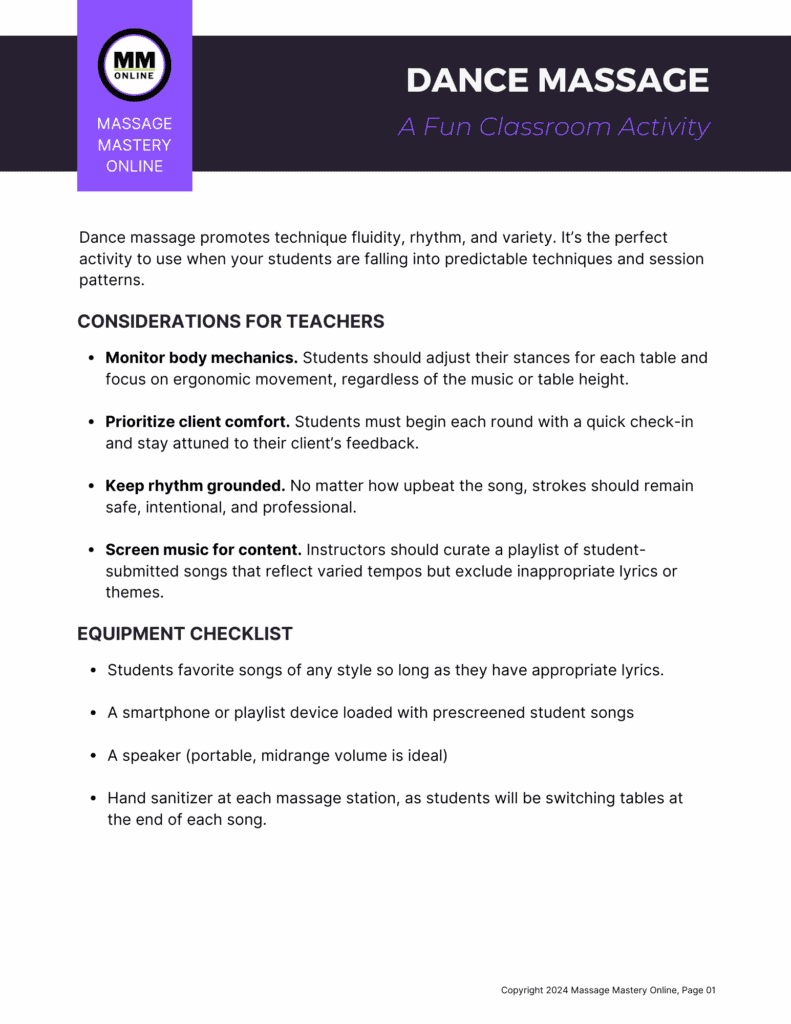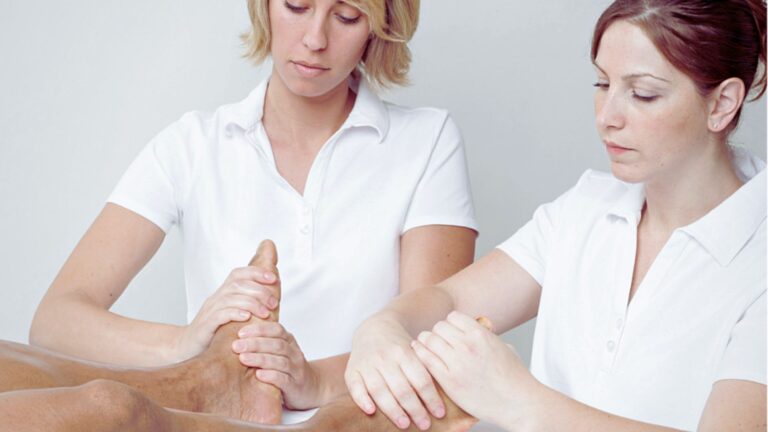Dance Massage: A Classroom Activity for Rhythm, Flow, and Variety
Massage students often hit a plateau where techniques start to feel repetitive and sessions become predictable. “Dance Massage” is an engaging, rhythmic, and lively classroom activity that restores fluidity, creativity, and embodiment to massage practice. This structured yet expressive method offers students a fresh way to practice techniques while connecting with music, movement, and the client. You can download a PDF of the activity directions at the end of this blog post.
As students give and receive massage during dance massage, they move out of their heads and into their hands. They learn to trust their bodies, vary their techniques, and stay fully present with the client in front of them. The music adds a spark of energy and emotion, encouraging exploration, spontaneity, and flow —three essential qualities of effective bodywork.
Why Dance Massage Works
- Promotes embodied awareness. Students connect more deeply with their own bodies, allowing intuition and kinesthetic intelligence to guide their touch.
- Encourages creative variation. Every song is different, and so is every client. Dance massage helps students break the habit of giving the same massage to everyone.
- Improves rhythm and fluidity. Matching techniques to music helps students vary their pace and create seamless transitions between techniques.
- Enhances client sensitivity. Students begin to recognize how rhythm supports client relaxation (think gentle rocking) or stimulation (upbeat percussion).
- Develops adaptability. Because students work on multiple bodies during the session, they gain valuable experience adjusting their approach to different shapes, sizes, and tissue qualities.
- Reduces injury risk. Moving more freely and mindfully supports the therapist’s own body mechanics and helps prevent repetitive strain.
Key Considerations for Instructors
- Monitor body mechanics. Students should adjust their stances for each table and focus on ergonomic movement, regardless of the music or table height.
- Prioritize client comfort. Students must begin each round with a quick check-in and stay attuned to their client’s feedback.
- Keep rhythm grounded. No matter how upbeat the song, strokes should remain safe, intentional, and professional.
- Screen music for content. Instructors should curate a playlist of student-submitted songs that reflect varied tempos but exclude inappropriate lyrics or themes.
Equipment Checklist
- A smartphone or playlist device loaded with prescreened student songs
- A speaker (portable, midrange volume is ideal)
- Hand sanitizer at each massage station, as students will be switching tables at the end of each song.
Directions
- Divide the Class: Assign half of the students to tables as clients. The other half are therapists.
- Set Expectations: Before beginning, review boundaries and consent, staying embodied and intuitive, adapting techniques to rhythm, maintaining body mechanics, and being mindful of different client types.
- Call Out the Region: For example: “Left posterior leg.” Give students a moment to undrape and apply lubricant.
- Start the Music and Say “Go”: Play a song from the curated playlist. Students begin massaging the targeted region, moving with the rhythm and embodying the spirit of the song—without compromising client comfort or technique quality.
- Switch: After 2–3 minutes (or the length of a song), call for therapists to sanitize their hands and rotate to a new client.
- Repeat: Call out a new body region, start a new song, and repeat the process until each student has practiced on several clients.
Processing the Experience
After the final round, gather the class into a circle for a short debrief. Processing helps students reflect on what they’ve learned and integrate the experience into their future practice. You might ask:
- What did you notice about your own body as you worked with the music?
- Did the music help you change the way you applied your techniques? How?
- Which song surprised you the most in terms of how it influenced your rhythm or pressure?
- What did you learn about adapting to different client bodies today?
- Will this activity influence how you approach your future massage sessions? Why or why not?
- What sensations or emotions came up for you as a client during the session?
In Closing
Dance massage invites students to massage with presence, rhythm, and joy. It reinforces essential massage skills—fluid transitions, body mechanics, adaptability, and safe client interaction—while reawakening creativity and movement in the classroom. Ready to try it in your classroom? Dance massage is easy to implement and impossible to forget. Add it to your teaching toolkit and watch your students move from hesitant to embodied, from rigid to rhythmic, and from routine to inspired. Looking for more ideas like this? Visit the Massage Classroom Coach resource page for free CE courses and downloadable teaching tools designed specifically for massage educators.

You can download the directions for Dance Massage to keep with your teaching materials.


